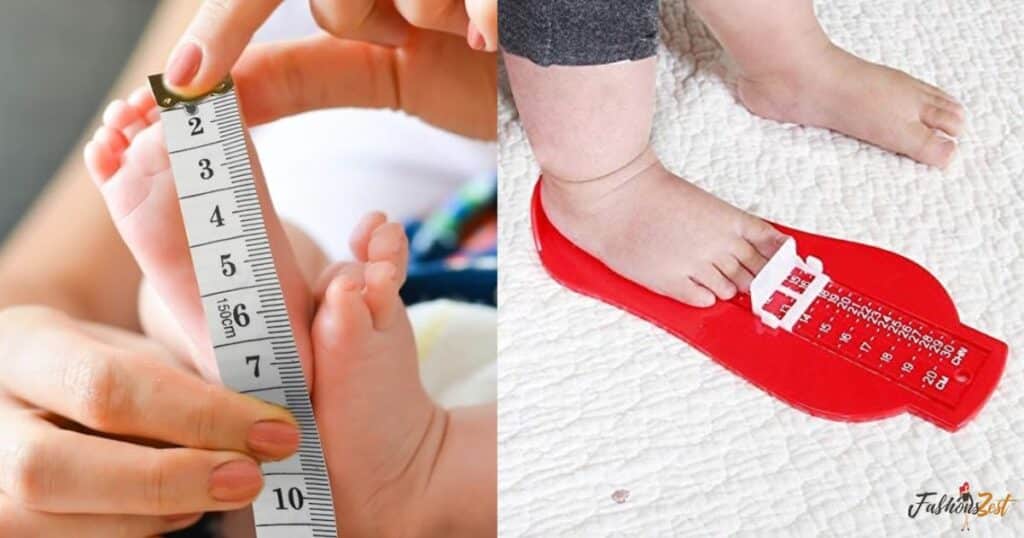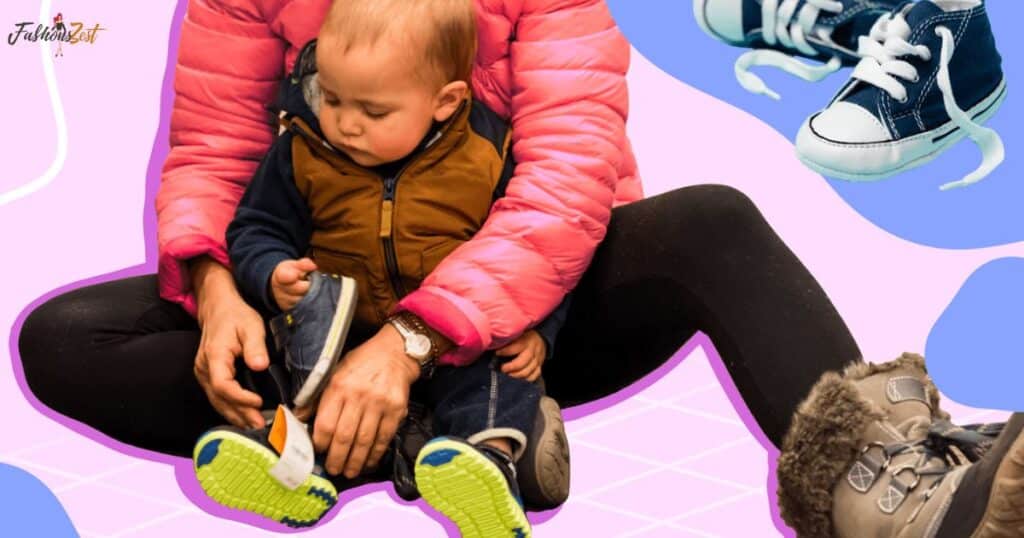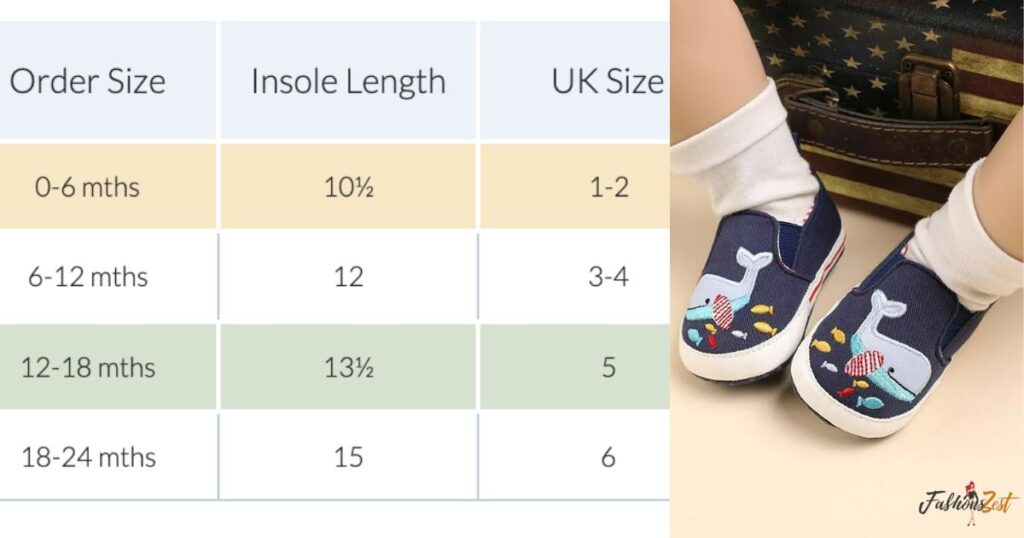It’s essential to choose the right fit for your little one’s growing feet. At this age most babies start wearing size 3 or 4 shoes. However, every child is unique so it’s crucial to measure their feet accurately. Remember, their shoes should be roomy enough for growth but not too loose to cause tripping.
Look for soft soled shoes to support their developing arches. Avoid stiff or heavy shoes that can hinder natural movement. Always check the fit by feeling for extra space around the toes and ensuring the shoes stay on securely. Keeping these tips in mind will help you find the perfect shoes for your 12 month old.
Baby Foot Development: Shoe Size at 12 Months
Understanding your baby’s foot development is crucial for choosing the right shoe size at 12 months. Proper footwear supports natural development and prevents discomfort. Here’s a breakdown:
| Key Points | Details |
| Typical Shoe Size | Size 3 or 4 for most babies |
| Sizing | Measure their feet accurately |
| Shoe Type | Opt for soft-soled shoes |
| Fit | Ensure room for growth |
Choosing the right shoes promotes healthy foot development supporting their growth. It’s essential to avoid stiff or heavy shoes that restrict movement. Regularly check the fit to accommodate their growing feet.
Measuring Tips for 12-Month-Olds’ Feet

Accurate measurement ensures proper shoe fit for your 12-month-old. Follow these tips to measure their feet effectively:
- Use a ruler or measuring tape.
- Measure both feet and use the larger measurement.
- Measure in the afternoon for accurate sizing.
- Leave a thumb’s width of space in front of toes.
Choosing the right shoe size ensures comfort and supports healthy foot development. Regularly measure their feet as they grow to accommodate changes.
Choosing Shoes for Your 12-Month-Old
When choosing shoes for your 12-month-old ensure they are soft lightweight and flexible to support natural foot development. Look for breathable materials to keep their feet comfortable. Measure their feet regularly and leave space for growth about a thumb’s width at the toe.
Avoid shoes with stiff soles or tight fits to prevent discomfort. Opt for adjustable closures like Velcro straps or elastic laces for easy on and off. Check the fit by feeling for extra space around the toes and ensuring the shoes stay on securely. Prioritize shoes that provide traction to prevent slips as they explore. Remember, the right shoes support their development and keep them comfortable on their adventures.
Factors in Selecting 12-Month-Olds’ Shoes

Selecting shoes for your 12-month-old involves considering several factors. First prioritize shoes that are lightweight and flexible to support their developing feet. Look for breathable materials to keep their feet comfortable and dry. Measure their feet regularly to ensure the right fit leaving room for growth about a thumb’s width at the toe. Avoid shoes with stiff soles that can hinder natural movement.
Opt for adjustable closures like Velcro straps or elastic laces for easy on and off. Check the fit by feeling for extra space around the toes and ensuring the shoes stay on securely. Consider the environment where your child will wear the shoes shoes with good traction are essential for stability and safety. By considering these factors you can choose shoes that promote healthy foot development and keep your little one comfortable as they explore the world.
Avoiding Common Shoe Buying Mistakes
Avoiding common shoe buying mistakes ensures your child’s comfort and foot health.
Here’s what you need to know:
- Measure both feet and choose the larger size.
- Consider shoe width for proper fit.
- Avoid buying shoes that need “breaking in”.
- Check the shoe’s flexibility and sole thickness.
- Ensure there is enough room for growth about a thumb’s width.
- Choose breathable materials to prevent sweating and discomfort.
By avoiding these common mistakes you can select shoes that support your child’s natural foot development and keep them comfortable throughout the day.
Read this blog: WHAT DOES BESPOKE MEAN IN FASHION
Shoe Size Charts for One-Year-Olds
Understanding shoe size charts for one-year-olds is crucial for proper fit. Here’s a breakdown:
| Age (Months) | US Shoe Size | UK Shoe Size |
| 12 | 3 – 4 | 2.5 – 3.5 |
| 15 | 4 – 5 | 3.5 – 4.5 |
| 18 | 5 – 6 | 4.5 – 5.5 |
A Using these shoe size charts ensures you select the right size providing comfort and support for your one-year-old’s growing feet. Regularly measure their feet to accommodate changes.
Flexibility and Support in Toddler Shoes
Flexibility and support are crucial factors when choosing toddler shoes. Look for shoes that bend easily at the ball of the foot to support natural movement. Opt for lightweight materials that allow for flexibility without sacrificing support. Shoes with sturdy heel counters provide stability and help prevent ankle injuries. Avoid overly rigid shoes that restrict movement and hinder proper foot development.
Look for cushioned insoles to provide comfort during all day wear. Additionally, ensure the shoes have secure closures like Velcro straps or elastic laces to keep them on securely. Prioritize shoes with good traction to prevent slips and falls especially as your toddler explores different surfaces. By choosing shoes that balance flexibility and support you can promote healthy foot development and keep your toddler comfortable and safe.
Shoe Width Considerations for 12-Month-Olds
Consider shoe width for proper fit and comfort. Ensure shoes aren’t too narrow which can cause discomfort. Look for options with adjustable closures to accommodate different foot widths. Wide width shoes are available for chubby or wider feet.
Avoid shoes that pinch or squeeze the sides of the foot. Check for enough room around the toes and sides to allow natural movement. Proper width prevents foot problems and ensures a happy, healthy toddler.
Signs Your 12-Month-Old Needs New Shoes
Watch for signs indicating your 12-month old needs new shoes. Check for tightness or discomfort around the toes or sides. Look for worn-out soles or uneven wear patterns. Monitor your child’s gait for any changes like tripping or stumbling.
Pay attention to complaints of discomfort or refusal to wear shoes. Check if their toes reach the front of the shoes when standing. Replace shoes if they no longer provide adequate support or flexibility. By observing these signs you can ensure your child’s shoes fit properly and support their growing feet.
Frequently asked questions
What size shoes does a 12-month-old wear?
Most wear size 3 or 4 shoes at this age.
How do I measure my 12-month-old’s feet for shoes?
Use a ruler or measuring tape; choose the larger size.
What should I consider when buying shoes for my 12-month-old?
Look for soft, flexible shoes with room for growth.
How often should I check my 12-month-old’s shoe size?
Regularly, as their feet grow quickly during infancy.
What features are important in shoes for a 12-month-old?
Prioritize soft soles, secure closures and proper fit.
Conclusion
Choosing the right size shoes for a 12-month-old is crucial for their comfort and foot development. By opting for size 3 or 4 shoes you can ensure a proper fit for most infants at this stage. Remember to measure their feet regularly to accommodate growth and provide enough room for their toes to wiggle. Prioritize shoes with soft soles and secure closures to support natural movement and keep them safe as they explore their world.
Understanding your 12-month-old’s shoe size helps you make informed decisions when shopping for footwear. Consider factors like flexibility, support and breathability to promote healthy foot development. Regularly checking their shoe size and observing signs of discomfort ensures they are always wearing the right shoes. By following these guidelines you can ensure your little one’s feet are well cared for and comfortable in their shoes.
Finding the right size shoes for your 12-month-old involves careful consideration and regular monitoring. By prioritizing comfort, support and proper fit you can ensure their feet develop healthily and comfortably. Stay attentive to their needs and adjust their footwear as they grow to support their ongoing exploration and development.

David a seasoned professional with 5 years of expertise in the fashion industry, brings creativity and passion to our website. Explore his rich background and insights in the dynamic world of fashion.







